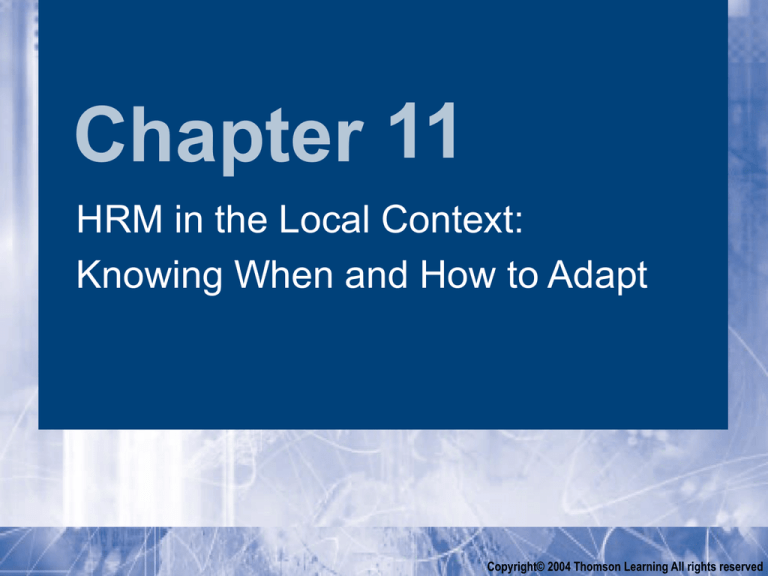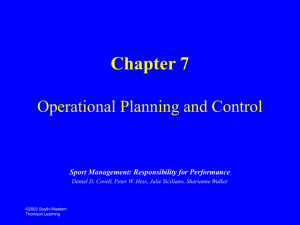
Chapter 11
HRM in the Local Context:
Knowing When and How to Adapt
Copyright© 2004 Thomson Learning All rights reserved
Learning Objectives
• Understanding how the national context affects HRM
practices
• Identify how recruitment and selection practices differ
in various national contexts
• Identify possible host adaptations in recruitment and
selection practices
Copyright© 2005 South-Western/Thomson Learning All rights reserved
Learning Objectives
• Identify how training and development techniques are
used in different countries
• Identify sources of high-quality workers in different
nations
• Understand how training must be adapted to host
country workers
• Identify how performance evaluation and
compensation practices differ in various national
contexts
Copyright© 2005 South-Western/Thomson Learning All rights reserved
Learning Objectives
• Identify possible host country adaptations in
performance evaluation and compensation practices
for a multinational company
• Understand how labor costs vary
• Have an appreciation of how the national context and
historical conditions affect the relationship of
management and labor
Copyright© 2005 South-Western/Thomson Learning All rights reserved
Why Do Nations Differ in
HRM?
• Because of the national context
• National culture and social institutions influence how
managers make decisions regarding strategies
• Countries vary widely with regards to social institutions
and national culture
• Multinationals must select and implement practices
that meet national context
Copyright© 2005 South-Western/Thomson Learning All rights reserved
Exhibit 11.1: How the National Context
Leads to National Differences in Local
HRM Practices
Copyright© 2005 South-Western/Thomson Learning All rights reserved
Why Do Nations Differ in
HRM?
• Resource pool: all the human and physical resources
available in a country
• Both from natural and induced factor conditions
• Include quality of labor, availability of scientific
laboratories
Copyright© 2005 South-Western/Thomson Learning All rights reserved
Key Factors that Influence the
Resource Pool
• The quality, quantity, and accessibility of raw material
• The quantity, quality, and cost of personnel available
• The scientific, technical, and market-related knowledge
available to firms
Copyright© 2005 South-Western/Thomson Learning All rights reserved
Resource Pool
• The cost and amount of capital available to firms for
operations and expansion
• The type, quality, and costs of supporting institutions
such as the systems of communication, education, and
transportation
Copyright© 2005 South-Western/Thomson Learning All rights reserved
Why Do Nations Differ in
HRM?
• Natural factor conditions: national resources that occur
naturally
• E.g., abundant water supply
• Induced-factor conditions: national resources created
by a nation
• E.g., superior educational system
Copyright© 2005 South-Western/Thomson Learning All rights reserved
Characteristics of the National
Context That Affect HRM
•
•
•
•
Education and training of the labor pool
Laws and cultural expectations for selection practices
Types of jobs favored by applicants
Laws and cultural expectations regarding fair wages
and promotion criteria
• Laws and traditions regarding labor practices
Copyright© 2005 South-Western/Thomson Learning All rights reserved
Recruitment Strategies
•
•
•
•
•
•
•
Walk-ins or unsolicited applications
Newspaper or Internet advertisement
Company Web site job posting
Internal job postings
Public and private personnel agencies
Placement services of educational institutions
Current employee recommendations
Copyright© 2005 South-Western/Thomson Learning All rights reserved
Exhibit 11.2: Steps in the
Recruiting Process
Copyright© 2005 South-Western/Thomson Learning All rights reserved
Recruitment in the U.S.
• U.S. managers tend to see newspapers as one of the
most effective recruitment methods.
• Fear that recruitment by personal contacts may result
in bias against some groups.
• U.S. value open and public advertisements as a
reflection of individualistic culture.
Copyright© 2005 South-Western/Thomson Learning All rights reserved
Exhibit 11.3: Most Effective
Recruiting Sources for U.S.
Companies
Copyright© 2005 South-Western/Thomson Learning All rights reserved
Recruitment in Korea
• Backdoor recruitment: prospective employees are
friends or relatives of those already employed
• Managers are recruited from prestigious universities
Copyright© 2005 South-Western/Thomson Learning All rights reserved
Recruitment Around the World
• Individuals around the world have preferred way to find
jobs
• International Social Survey Program data was
analyzed
• Looking for jobs through public vs. private agencies
• Individuals in former communist and socialist
societies were more likely to rely on public agencies
Copyright© 2005 South-Western/Thomson Learning All rights reserved
Recruitment Around the World
(cont.)
• Advertising in newspapers and responding to
newspaper ads
• Both very public forms of recruitment
• Individualistic societies have higher preference for
such forms
• Apply directly versus asking friends/relatives for job
• Individualistic and high femininity societies more
likely to favor direct application
• Socialist societies rely on asking friends/relatives
Copyright© 2005 South-Western/Thomson Learning All rights reserved
Exhibit 11.4: Preferred Ways to
Look for a New Job—Public vs.
Private Agency
Copyright© 2005 South-Western/Thomson Learning All rights reserved
Exhibit 11.5: Preferred Ways
to Look for a New Job
Copyright© 2005 South-Western/Thomson Learning All rights reserved
Exhibit 11.6: Preferred Ways
to Look for a New Job
Copyright© 2005 South-Western/Thomson Learning All rights reserved
Selection in the U.S.
•
•
•
•
•
Job qualifications
Match skills and job requirements
Individual achievements
Prohibitions against nepotism—the hiring of relatives
Forbidding managers to supervise family members
Copyright© 2005 South-Western/Thomson Learning All rights reserved
Exhibit 11.7: Typical Steps in
U.S. Personnel Selection
Copyright© 2005 South-Western/Thomson Learning All rights reserved
Selection in Collectivist
Cultures
• Based on the in-group
• Preference for family
• Value potential trustworthiness, reliability, and loyalty
over performance-related background
• High school and university ties substitute for family
membership
Copyright© 2005 South-Western/Thomson Learning All rights reserved
Implications for the
Multinational: Recruitment
and Selection
• Managers must follow local norms to get best workers
• Often a tradeoff between home practices and costs of
following local traditions
Copyright© 2005 South-Western/Thomson Learning All rights reserved
Training and Development
• Need for training and development varies by country
• Differences in training and development due to
• Differences in educational systems
• Values regarding educational credentials
• Cultural values regarding other personnel practices
Copyright© 2005 South-Western/Thomson Learning All rights reserved
Exhibit 11.8: Training Systems
around the World
Copyright© 2005 South-Western/Thomson Learning All rights reserved
Exhibit 11.9: Key Specific Training
and Development Characteristics
of Selected Countries
Copyright© 2005 South-Western/Thomson Learning All rights reserved
Exhibit 11.9: Key Specific Training
and Development Characteristics
of Selected Countries
Copyright© 2005 South-Western/Thomson Learning All rights reserved
Exhibit 11.9: Key Specific Training
and Development Characteristics
of Selected Countries
Copyright© 2005 South-Western/Thomson Learning All rights reserved
Exhibit 11.9: Key Specific Training
and Development Characteristics
of Selected Countries
Copyright© 2005 South-Western/Thomson Learning All rights reserved
Exhibit 11.9: Key Specific Training
and Development Characteristics
of Selected Countries
Copyright© 2005 South-Western/Thomson Learning All rights reserved
Training and Development in
the U.S.
• Companies with over 100 employees invest more than
$60 billion in training costs.
• Management development and computer skills are the
most popular.
• There is growing pressure for training as the U.S. shifts
to the service sectors.
Copyright© 2005 South-Western/Thomson Learning All rights reserved
Exhibit 11.10: Skills Taught by
U.S. Organization
Copyright© 2005 South-Western/Thomson Learning All rights reserved
Training and Development in
Germany
• Two major forms of vocational education
• General and specialized vocational schools and
professional and technical colleges
• Dual system: combination of in-house apprenticeship
training with part-time vocational-school training, and
leads to a skilled certificate
• Meister: a master technician
Copyright© 2005 South-Western/Thomson Learning All rights reserved
German Dual System
• Stems from collaboration among employers, unions,
and the state
• Costs shared between companies and state
• Employers have obligation to release employees for
training
Copyright© 2005 South-Western/Thomson Learning All rights reserved
Exhibit 11.11: Skilled Worker
Training in Germany
Copyright© 2005 South-Western/Thomson Learning All rights reserved
Exhibit 11.12: Germany’s
Apprenticeship Program
under Pressure
Copyright© 2005 South-Western/Thomson Learning All rights reserved
Training and Development in
the U.S.
• Senior level managers often identify managerial
potential
• Appraisals of managerial readiness based on
• Assessment centers
• Mentoring
• “Fast track” careers
• Remains the responsibility of the individual
Copyright© 2005 South-Western/Thomson Learning All rights reserved
Training and Development in
Japan
•
•
•
•
Permanent employment
Recruitment directly from universities
Join the company as a group
Selected on personal qualities that fit the corporate
culture
• Similar pay and promotion for first ten years—age
seniority
• Informal recognition of those high performing
managers
Copyright© 2005 South-Western/Thomson Learning All rights reserved
Training and Development in
Japan
• Shifting social institutions: pressures for change
• Asahi ties promotions to evaluations
• Matsushita uses merit pay for managers
• Honda is phasing out seniority
Copyright© 2005 South-Western/Thomson Learning All rights reserved
Implications for the
Multinational: Training and
Development
• Examine feasibility of exporting training
• IHRM orientation affects training needs of local
managers
• Locations advantages
Copyright© 2005 South-Western/Thomson Learning All rights reserved
Exhibit 11.13: Workers of the
Future: Student Math and Science
Scores from Selected Countries
Copyright© 2005 South-Western/Thomson Learning All rights reserved
Performance Appraisal
• Identifying people to reward, promote, demote, develop
and improve, retain, or fire
• Not everyone can climb the corporate ladder
• Need to assess how employees perform
Copyright© 2005 South-Western/Thomson Learning All rights reserved
U.S. Performance Appraisal
• U.S. legal requirements regulate performance
evaluation practices to ensure their fairness
• Performance evaluations must relate clearly to the job
and performance
• Performance standards must be provided in writing
• Supervisors must be able to measure the behaviors
they rate
Copyright© 2005 South-Western/Thomson Learning All rights reserved
U.S. Performance Appraisal
(cont.)
• Supervisors must be trained to use evaluation
measures
• Supervisors and subordinates must discuss appraisals
openly
• Appeals procedures must be in place
Copyright© 2005 South-Western/Thomson Learning All rights reserved
Performance Appraisal in
Collectivist Cultures
• Managers work indirectly to sanction poor performance
• Often avoid direct performance appraisal feedback
Copyright© 2005 South-Western/Thomson Learning All rights reserved
Exhibit 11.14: Cross-National
Differences in Purposes of
Performance Appraisals
Copyright© 2005 South-Western/Thomson Learning All rights reserved
Compensation
• Wages and salaries, incentives such as bonuses, and
benefits such as retirement contributions
• Wide variations on how to compensate workers
Copyright© 2005 South-Western/Thomson Learning All rights reserved
Compensation in the U.S.
• Wages and salaries differ based on two major factors
• External: include local and national wage rates,
government legislation, and collective bargaining
• Internal: include the importance of the job to the
organization, its ability to pay, and the employee’s
relative worth to the business
Copyright© 2005 South-Western/Thomson Learning All rights reserved
Compensation: Japan
• Traditional approach
• Base salaries on positions
• Skill and educational requirements
• Age
• Marital status and family size may count
• Bonus system: employees often receive up to 30%
of their base salary during traditional gift-giving
seasons
Copyright© 2005 South-Western/Thomson Learning All rights reserved
New Merit (Japanese style)
• Can affect pay raises to a greater degree than
traditional position/seniority system
• Nenpo system: based on yearly performance
evaluations that emphasize goals
• Although goals are not always the same as in
Western companies
• Stresses attitudes as much as performance
Copyright© 2005 South-Western/Thomson Learning All rights reserved
Exhibit 11.15: The Japanese
Pay Raise Formula: Changing
the Balance
Copyright© 2005 South-Western/Thomson Learning All rights reserved
Implications for the
Multinational: Performance
Evaluation and Compensation
• Match HRM orientation
• Seek location advantages in wages
Copyright© 2005 South-Western/Thomson Learning All rights reserved
Exhibit 11.17: Labor Costs and
Hours Worked Per Week in
Selected Countries
Copyright© 2005 South-Western/Thomson Learning All rights reserved
A Comparative View of Labor
Relations
• Patterns of labor relations depend on:
• Historical factors
• Ideology reasons
• Management views of unions
Copyright© 2005 South-Western/Thomson Learning All rights reserved
Union-Membership Density
• Proportion of workers in a country who belong to
unions
• Germany: estimated 40% belonged to trade unions
• U.S.: 14.2% of nonagricultural workforce
• Denmark: over 80% unionized
• Great Britain: approximate 50% unionized
Copyright© 2005 South-Western/Thomson Learning All rights reserved
Exhibit 11.18: Union Density in
Selected Countries
Copyright© 2005 South-Western/Thomson Learning All rights reserved
Historical and Institutional
Differences: Germany
• Germany
• Formalized, legalistic, and low-conflict bargaining
between unions and large corporations
• French
• Militant/strong ideologies
• U.S.
• “Bread and butter” issues: wages, benefits, and
working conditions
Copyright© 2005 South-Western/Thomson Learning All rights reserved
Union Structures
• Enterprise union: represents all people in one
organization, regardless of occupation or location
• Craft union: represents people from one occupational
group, such as plumbers
• Industrial union: represents all people in a particular
industry, regardless of occupational type
Copyright© 2005 South-Western/Thomson Learning All rights reserved
Union Structures (cont.)
• Local union: represents one occupational group in one
company
• Ideological union: represents all types of workers
based on some particular ideology or religious
orientation
• White collar or professional union: represents particular
occupational group, similar to craft union
Copyright© 2005 South-Western/Thomson Learning All rights reserved
Exhibit 11.19: Popular Form of
Unions in Selected Countries
Copyright© 2005 South-Western/Thomson Learning All rights reserved
Implications for the Multinational:
The Search for Harmony
• Must deal with local labor practices
• A factor in location choice
Copyright© 2005 South-Western/Thomson Learning All rights reserved
Exhibit 11.21: Who Gets
Along?
Copyright© 2005 South-Western/Thomson Learning All rights reserved








